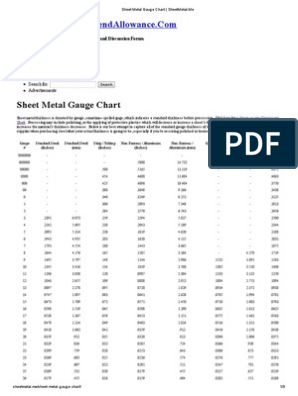Unit of thickness of a metal sheet or wire.
Gauge definition sheet metal.
Sheet metal thickness gauges for steel are based on a weight of 41 82 pounds per square foot per inch of thickness.
A sheet metal gauge sometimes spelled gage indicates the standard thickness of sheet metal for a specific material.
A measure of thickness for sheet metal.
The larger the gauge number the thinner the metal.
A gauge conversion chart can be used to determine the actual thickness of sheet metal in inches or millimeters.
Commonly used steel sheet metal ranges from 30 gauge to about 7 gauge.
So inversely the smaller the gauge number the thicker the metal.
Why gauge thickness matters.
For example 18 gauge steel according to a gauge conversion chart is 0 0478 inch or 1 214 millimeter.
1 for sheet metal a retrogressive scale higher numbers mean lower thickness that starts with 10 gauge representing a thickness of 3 416 millimeters or 0 1345 inches.
Sheet metal gauge size chart gauge or gage sizes are numbers that indicate the thickness of a piece of sheet metal with a higher number referring to a thinner sheet.
In the u s the thickness of sheet metal is commonly specified by a traditional non linear measure known as its gauge.
In most of the world sheet metal thickness is consistently specified in millimeters.
As the gauge number increases the material thickness decreases.
As the gauge number increases the thickness drops by 10 percent for example a 12 gauge sheet is 2 732 millimeters thick and a 13 gauge sheet is 2 391 millimeters thick.
The larger the gauge number the thinner the metal.

